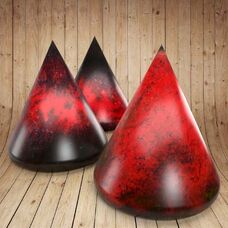Artistic glazes (Aventurines) for use in your pottery house
DEEP SPACE SPARKLE - Artistic Glaze (Aventurine) by Degussa
DEEP SPACE SPARKLE is Cone 06 oxidation aventurine glaze that looks as high fired reduction stoneware glazes. Aventurine..
1.35€
MERCURY - Transform Your Pottery: Discover Mercury Effect Ceramics Glaze
"Mercury Effect Glaze" is a specialized type of glaze used in pottery and ceramics, typically for earthenware. This glaz..
1.49€
ASPHALT - Effect Glaze Matt Cover Opaque
Quantity: 40 g. (1,41 oz.) Firing temperature: 880-1000°C (1616-1832° F) (up to Orton cone SSB 06) S..
1.35€
BABY BLUE - Artistic glaze by Johnson Matthey (Aventurines)
Quantity: 40 g. (1,41 oz.) Firing temperature: 1040-1100°C (1900-2000° F) (up to Orton cone SSB 03) ..
1.35€
DESIRE RED - Artistic Glaze (Aventurine) by Johnson Matthey
Desire Red is Cone 06 oxidation aventurine glaze that looks as high fired reduction stoneware glazes. Aventurine effects..
1.35€
JONQUIL YELLOW Artistic Glaze by Johnson Matthey
JONQUIL YELLOW is Cone 06 oxidation aventurine glaze that looks like high fired reduction stoneware glazes. Aventurine e..
1.25€
SPINDRIFT GREEN
Quantity: 40 g. (1,41 oz.) Firing temperature: 940-1000°C (1700-1830° F) (up to Orton cone SSB 06) S..
1.35€








